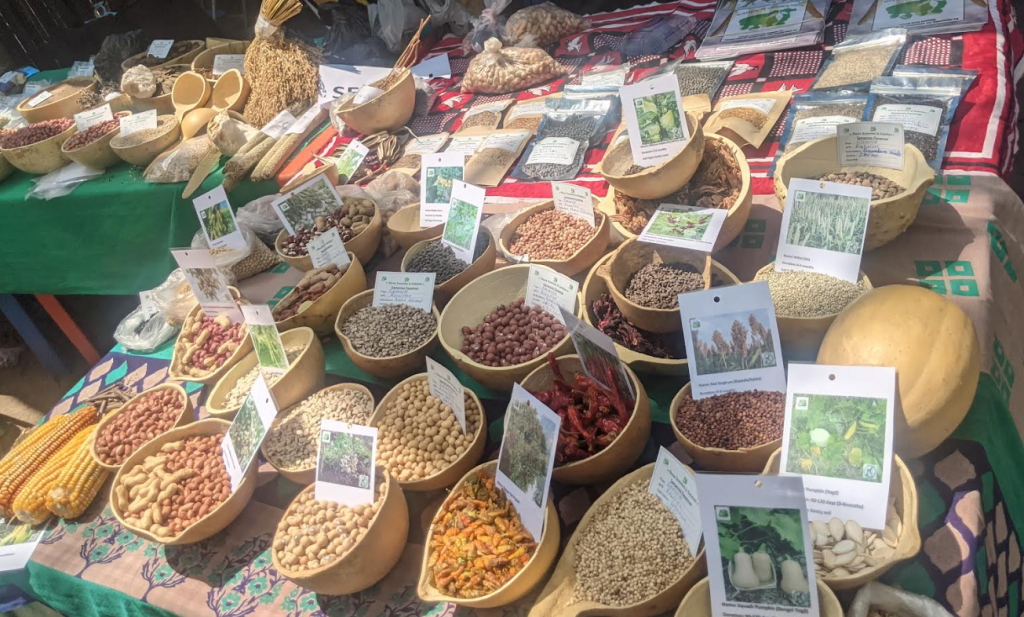
AMONG several climate mitigation approaches under discussion at this year’s United Nations Climate Summit (COP28) in Dubai from November 30 to December 12 is nature-based solutions (NBS).
While the notion of NBS focuses mostly on the food production side including forest management, African mass markets give nature-based food systems a much broader and deeper meaning in ways that demonstrate the value of biodiversity and contextual responses to climate change.
Expanding the boundaries of nature-based food systems
Every African country has booming indigenous markets where most smallholder farmers get their income, and most low-income consumers get affordable food. For instance, Kampala the capital city of Uganda has close to 90 such markets that are more popular than supermarkets. These markets are driven by principles of indigenous commerce based on social aspects like knowledge is a public good that are often missing in neo-liberal market systems.
Some of the fundamental ways in which African indigenous markets expand the boundaries of nature-based food systems are described below:
Mass markets increase the demand and consumption of natural indigenous food
The last few years have seen an increase in the consumption of indigenous fruits, indigenous vegetables and tubers that used to be marginalised in most African countries.
Growing consciousness on eating health is driving this trend as consumers increasingly associate local indigenous food with natural remedies.
- Open letter to President Mnangagwa
- Feature: ‘It’s worse right now than under Mugabe’: Sikhala pays the price of opposition in solitary cell
- Masvingo turns down fire tender deal
- Human-wildlife conflict drive African wild dogs to extinction
Keep Reading
Attention is also swinging back to preserving indigenous seed, food and natural ecosystems as communities see more economic, nutritional and social value of natural chemical-free food systems. Without the mass market, many communities would not know the value of their indigenous fruits like baobab and many others.
Through indigenous markets, communities have realised extra value for their natural resources beyond just consumption, leading to protection.
Mass markets provide rich insights into return on investment (ROI) in natural resources
After meeting consumption needs, most smallholder farmers and indigenous people take surplus commodities to mass markets which absorb most of the food compared to formal markets like supermarkets.
Income from the people’s market show how farmers are earning meaningful return from their soils, water, micro-climates, and labour.
For instance, the market can show that farmers are earning more than US$1 000 from the same piece of land this season compared to last season due to drought-related shortages or more demand from consumers. Such indicators come from the mass market, reflecting changes in income from the same piece of land.
Mass markets track the seasonality of food commodities
African mass markets can show the significance of seasons in food systems by showing supply changes between months and seasons.
If indigenous fruits were abundant during the same time last season, why is supply low this season? What is causing fluctuations in supply periods of indigenous fruits?
Such questions can be answered by indigenous markets through tracking sources of the commodities from production zones.
Some reasons could be cultural or spiritual which, in most cases, are undocumented influences requiring engagement with custodians of indigenous knowledge systems (IKS) which have their own cultural and spiritual explanations.
Indigenous mass markets as sources of early warnings
Ordinary people may not have much control on the production of some indigenous foods whose abundance or scarcity could be explained through IKS. However, indigenous markets have become adept at predicting rainfall patterns. Although some natural products can be confined to some regions, comparative assessment when these commodities come to the market provide reasons about production and supply trends.
For instance, the markets combine IKS from Dande with indigenous beliefs from other communities to provide early warnings about the coming season.
Indigenous mass markets as indigenous knowledge sharing platforms
Some of the knowledge shared in mass markets provide solutions to nature and ecosystems threatened by disruption. For instance, farmers and traders can gather information and knowledge on how other communities are preserving water and soils to produce sweet potatoes all year round without artificial irrigation. Many farmers can acquire this knowledge from the market.
Restoring identity through indigenous mass markets
Indigenous markets have reached a point where they are creating an identity for certain value chains and their communities.
For example, while growing indigenous food like yams (madhumbe) might not be of financial benefit for some communities, they provide reasons for some communities like Chipinge in Zimbabwe to protect the ecosystem in which madhumbe grows naturally.
Likewise, communities where edible insects like harurwa are a key component of food systems work hard to preserve their ecosystems.
These communities have realised that their production area has a spiritual undocumented angle which scientists have failed to understand but the community is getting economic value which encourages preservation of the ecosystem.
Indigenous markets build resilience through redistributing natural resources benefits
Mass markets have become distributors of natural resource benefits where in one region a certain commodity produced by its natural resources is benefiting other regions.
For instance, in most African countries there are cases where climatic conditions of natural region 1 are benefiting those in region five — thanks to the equitable benefit sharing power of mass markets.
The role of indigenous mass markets in directing investment priorities
Indigenous markets also inform and direct investment priorities in natural resources by making farming communities realise they can get best returns from their resources in the mass market.
For example, Gokwe farmers in Zimbabwe were informed by the mass market to move from cotton to sweet potatoes to earn the best return on investment from their soil, water and micro-climate. The communities have realised that a favourable ecosystem can be a powerful economic driver. If a community has an ecosystem best for sweet potatoes, it will preserve all elements including climate for sweet potatoes. Some communities are preserving wetlands because, from wetlands, they get more value like selling the first groundnuts and green mealies in mass markets.
Mass markets protecting indigenous food as commodities fight for space
In most African countries, there is now stiff competition for consumer budgets between the usual so-called staple foods and indigenous foods which are dismantling the standard food security template to accommodate previously marginalised foods.
For instance, wheat is losing income to sweet potatoes. This is how indigenous markets are becoming key institutions in protecting the fruits of natural resources by giving space to diverse commodities.
Why other types of markets cannot do what indigenous markets do
In a comparative sense, what is done by indigenous African markets cannot be done by other types of markets like supermarkets and processing companies because institutional set ups in these other markets are far from being a platform for knowledge exchange.
In addition, formal procurement processes in these other markets have no direct links with sources of products.
Formal companies sometimes buy from export markets based on company policy or what they consider more beneficial.
On the other hand, indigenous markets have direct links with food production ecosystems.
Indigenous markets and traders are at the centre of converging knowledge which is not the case in formal systems that tend to over-protect certain information for competitive purposes.
Bigger impacts on nature-based solutions are seen in indigenous markets because that is where the public good nature of information and knowledge provides a big picture of disruptions and benefits to NBS.
There is need for a holistic approach that involves education and evidence showing what communities are losing in terms of potential benefits.
It is through participatory awareness that communities rebuild consciousness on the importance of their natural resources.
More important is a holistic approach on the extent to which communities can be empowered to inform and direct their investment priorities based on what they perceive as direct benefits.
- Charles Dhewa is a proactive knowledge broker and management specialist









